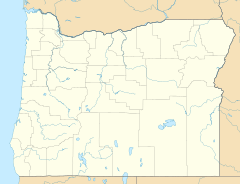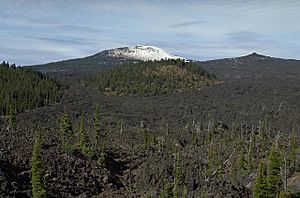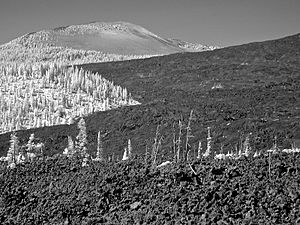Belknap Crater facts for kids
Quick facts for kids Belknap Crater |
|
|---|---|
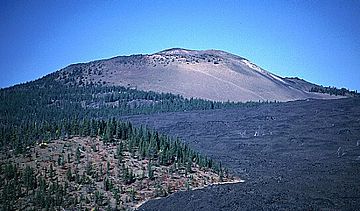
Belknap shield volcano with lava flows in foreground
|
|
| Highest point | |
| Elevation | 6,876 ft (2,096 m) NAVD 88 |
| Geography | |
| Location | Linn County, Oregon, U.S. |
| Parent range | Cascades |
| Topo map | USGS Mount Washington |
| Geology | |
| Mountain type | Shield volcano |
| Volcanic arc | Cascade Volcanic Arc |
| Last eruption | 480 AD |
Belknap Crater is a shield volcano found in the Cascade Range in Oregon, U.S.. It is located in Linn County. Belknap Crater is known for its lava fields and smaller volcanic features like Little Belknap and South Belknap. It sits north of McKenzie Pass and is part of the Mount Washington Wilderness. Belknap Crater does not have many trees, and most of its lava flows are bare. However, some wildlife lives around the volcano. You can also find "tree molds" there, which are shapes left behind by trees caught in ancient lava flows.
Belknap Crater was named after J. H. Belknap. His father, R. S. Belknap, started Belknap Springs. Old travel routes passed near Belknap and its lava fields. In the early 1900s, sheep grazed on two hills surrounded by lava flows from Little Belknap. The Oregon Skyline Trail, which goes west of Belknap's lava, follows paths used by Native American people. They used to gather huckleberries in this area. Today, many trails run near Belknap, including ones to Little Belknap and Belknap Crater itself. Visitors can see Belknap from the Dee Wright Observatory. This observatory was partly built using lava blocks from Belknap Crater.
Scientists are not sure exactly how old Belknap Crater is, as its early history is unclear. It has likely grown from many eruptions over a long time. Belknap Crater has had four confirmed eruption periods in the last 11,700 years. The entire Belknap volcano, with its many vents, formed in less than 1,500 years. Its last eruption ended about 1,500 years ago. Belknap grew on the lower slopes of Mount Washington, an older, worn-down volcano. It is one of the larger volcanoes rich in magnesium and iron in the Sisters Reach area.
Belknap is a shield volcano with a pyroclastic cone (a cone made of volcanic rock fragments). It is made of basalt and basaltic andesite lava. These rocks are typical of the High Cascade volcanoes. The volcano is well-preserved. Its center is made of cinder materials. Its lava flows have clear pressure ridges (mounds) and levees (natural walls). There are several smaller features, including the Inaccessible Cones, Little Belknap, South Belknap, and Twin Craters. The Belknap hot springs are also nearby. Eruptions of magma rich in magnesium and iron are more common in the Sisters Reach area (which includes Belknap) than anywhere else in the Cascade volcanic arc. However, the Volcano Hazards Program thinks it is unlikely that Belknap will erupt again soon.
Contents
Where is Belknap Crater?
Belknap Crater is located north of the Three Sisters in Oregon. It is in Linn County and is part of the central Cascade Range. Experts have called Belknap "one of the important features of the Cascade Range." It is north of McKenzie Pass and can be seen from McKenzie Highway.
Belknap Crater's top is about 6,876 feet (2,095 meters) high. It looks "bald" because it has little vegetation. The main Belknap shield volcano is about 5 miles (8 kilometers) wide. It is about 1,700 feet (518 meters) thick. Belknap Crater is a wide, gently sloped shield volcano compared to other volcanoes rich in magnesium and iron. Its summit cone rises about 400 feet (122 meters) above the main shield. The volcano itself rises about 1,600 feet (488 meters) above the land around it.
Oregon Route 242 goes through the lava fields made by Belknap Crater. It also passes the Yapoah cinder cone and other volcanic vents. These fields are made of black, basaltic lava. They cover an area of about 85 square miles (220 square kilometers).
What is the area like?
Belknap Crater is part of the Mount Washington Wilderness. This wilderness area covers about 54,278 acres (220 square kilometers) of lava and flat lands. Many lodgepole pine trees grow here. There are also 28 lakes in the wilderness. Belknap itself is not covered in trees. Its lava flows usually have no plants growing on them. However, some trees were seen on its lava flows in the 1960s. Later, only a few trees were found on lava flows from Little Belknap. The soil from Belknap is about 3 feet (1 meter) thick. It is made of small volcanic rocks and volcanic ash, mostly from Belknap Crater.
Along the trail to Little Belknap Crater, there is a small group of trees. These include lodgepole pine, mountain hemlock, and true fir trees. You can also see ground squirrels running on the lava flows from Belknap. The Oregon Skyline Trail passes west of Belknap. Here, you might spot black-tailed and mule deer. Lakes in the area are stocked with Eastern brook trout.
On the western lava flows from Belknap, there are dozens of tree molds. These are holes left where trees once stood. They are about 1 to 5 feet (0.3 to 1.5 meters) wide and 6 to 15 feet (1.8 to 4.6 meters) deep. Some trees fell into the lava, forming half-cylinder-shaped trenches up to 35 feet (10.7 meters) long. Scientists found charred roots under the soil at one of these molds. Dating these roots showed they were from around 360 AD.
How did Belknap Crater form?
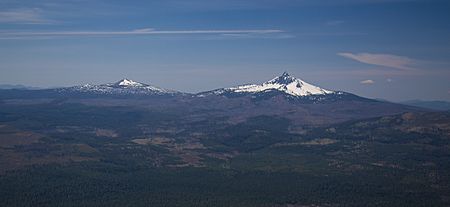
The Cascade Range formed when the Juan de Fuca tectonic plate slid under the North American tectonic plate. The High Cascade area in central Oregon formed about 155 to 186 miles (250 to 300 kilometers) east of where these plates meet. The High Cascade area has many layers of lava flows. These flows came from shield volcanoes over the last 2 million years. Cascade shield volcanoes are steeper and smaller than Hawaiian ones. They often have cinder cones at their tops.
Belknap is the youngest shield volcano in the Cascade arc. Its rough, bare lava fields look very different from the tree-covered fields of older Cascade shield volcanoes. It is in the central Oregon part of the Cascades, near the Three Sisters area. This area has many volcanoes close together, including Mount Bachelor, the Three Sisters, and Belknap.
This cluster of volcanoes is called the Sisters Reach. It is about 56 miles (90 kilometers) long. There are at least 466 volcanoes from the last 2.6 million years in the Sisters Reach. Between the North Sister and Three Fingered Jack volcanoes, there has been a lot of volcanic activity in the last 11,700 years. At least 125 volcanoes became active between 4,000 and 1,300 years ago. Belknap was the last volcano to erupt in the Three Sisters area. Most of the lava from these volcanoes is basaltic andesite.
Belknap is one of the larger volcanoes rich in magnesium and iron in the Sisters Reach. More than 30 such volcanoes are in this area. The area around Belknap and Mount Bachelor has extensional tectonics. This means the Earth's crust is pulling apart, leading to many volcanic vents rich in magnesium and iron. Some patterns among volcanoes, like at Sand Mountain and Inaccessible Cone, suggest there are faults (cracks) underground. Belknap's alignment with other features might also mean there are faults deep below.
Belknap formed on the lower slopes of Mount Washington, an older, worn-down volcano. Mount Washington's peak is about 3 miles (5 kilometers) from Belknap. Belknap is a shield volcano and a pyroclastic cone. Together, they form a complex from the late Holocene (last 11,700 years). It is made of basalt and basaltic andesite lava. This lava is rich in magnesium and iron, typical of High Cascade volcanoes. Besides its main shield vents, the Belknap complex also has lava flows and tephra (rock fragments) from a central vent and other side vents. Its lava flows cover about 39 square miles (100 square kilometers). Its center is made of pyroclastic material. The southern of the two craters on Belknap's summit cone is about 250 feet (76 meters) deep and more than 1,000 feet (305 meters) wide at its edge.
Belknap is one of three main lava fields in its area, along with Sand Mountain and Yapoah–Four-in-One–Collier. Belknap is the largest. It includes Belknap Crater's shield, Little Belknap, and South Belknap cone. Lava flows in the area look black and glassy and have a vesicular texture (full of small holes). The basalt and basaltic andesite lava flows from Belknap contain small crystals of plagioclase and olivine. Some lava flows trapped charcoal. The lava flows show few signs of weathering (breaking down) or mineral alteration (changing minerals). They have solid centers and rough outer surfaces with jagged volcanic blocks. The centers of lava deposits are hard to reach, except in lava tubes or road cuts.
Belknap is well-preserved and shows how volcanoes acted in the High Cascades during the Holocene. Its center is made of cinder, surrounded by a wide shield. It is a medium-sized volcano, bigger than small cinder cones but smaller than large volcanoes like Mount Washington. Many of Belknap's lavas have rough crusts with slag or volcanic blocks. A smaller number have smooth, pāhoehoe (ropy) surfaces. The deposits are piles of basaltic andesite shards. These formed when lava tubes collapsed or when the outside of lava flows cooled while the inside kept moving. One expert said Belknap "is only a pile of cinders on the summit of a vast shield of recent lava." The estimated amount of cinders at Belknap Crater is about 75 million cubic yards (57 million cubic meters).
Belknap's volcanic deposits have well-preserved pressure ridges (mounds) and levees (walls) on their surfaces. They were laid down between 7,000 and 1,300 years ago. Volcanic ash from Sand Mountain Volcanic Field and Belknap covers a large area. This ash is younger than the Mazama Ash deposits. Cinder cones near Inaccessible Cone have been almost completely buried by basalt and basaltic andesite from Belknap. Belknap's ash deposits are dark and can be seen in road cuts.
What are Belknap's notable features?
| Name | Elevation | Coordinates |
|---|---|---|
| Belknap Crater | 6,876 feet (2,096 meters) | 44°17′06″N 121°50′32″W / 44.284943458°N 121.842233094°W |
| Inaccessible Cones | 4,869 feet (1,484 meters) | 44°18′12″N 121°54′23″W / 44.30331°N 121.90649°W |
| Little Belknap | 6,306 feet (1,922 meters) | 44°16′57″N 121°49′34″W / 44.2826179°N 121.8261628°W |
| South Belknap | 5,863 feet (1,787 meters) | 44°16′03″N 121°50′42″W / 44.26751°N 121.84507°W |
| Twin Craters | 5,285 feet (1,611 meters) | 44°15′12″N 121°53′09″W / 44.2534523°N 121.8858860°W |
Little Belknap shield formed about 3,000 years ago. It sits near a 492-foot (150-meter) high scoria cone of the main Belknap Crater. Mount Washington is also nearby. Little Belknap is about 1 mile (1.6 kilometers) east of Belknap shield's summit craters. It erupted on the side of the larger Belknap Crater. Little Belknap does not have scoria cones. This might be because its magma had already released its gases before erupting.
Eruptions at Little Belknap were "quiet" but produced a lot of lava. This created a separate shield volcano. It is topped with cinders and lava blocks. Collapsed lava tubes spread out from it. One western tube connects to a vertical tunnel about 20 feet (6 meters) wide. Little Belknap's lava flows reached within 1 mile (1.6 kilometers) of Windy Point to the east. They also reached McKenzie Pass to the southeast. These flows covered ash from Belknap Crater and were later covered by lava from Yapoah Cone. Along the Skyline Trail, some lava flows from Little Belknap cooled and folded back on themselves. This created overturned slabs of hardened lava up to 10 feet (3 meters) wide and 50 feet (15 meters) long.
There is a small lava cave system near the top of Little Belknap. Its roof is made of spatter material. The cave system is short and has several lava tubes. At the bottom of a vertical tunnel, there is another system of lava tubes. This tunnel connects the upper and lower cave levels. It is about 20 feet (6 meters) wide and drops 24 feet (7.3 meters). It has an oval shape and a smooth lining with lava stalactites.
South Belknap is a small volcano about 1 mile (1.6 kilometers) south of Belknap. Lava flows broke through its southwestern side. These flows also spread over Belknap Crater's southern base. Early lava flows near South Belknap were covered by a later flow. This later flow came from a vent about 300 feet (91 meters) northwest. It also covered the western part of Belknap Crater's lava. Then it reached Lake Valley, forming the northern shore of Hand Lake.
On top of Belknap Crater, there is a 400-foot (122-meter) high cinder cone. This might be the top part of its inner core. Inside it are three craters of different sizes. They line up in a north-northwest direction. The southern crater is large and produced most of the ash that covers the area. The northernmost crater is smaller. It erupted ash and a lava flow that broke through its rim.
Besides the volcanoes linked to Belknap Crater, two other volcanoes south of Belknap were also active recently: Four-in-One Cone and Collier Cone. Another unnamed cone to the north of Inaccessible Cone is about 300 feet (91 meters) tall. Gray basalt lava, older than Sand Mountain Volcanic Field and Belknap, broke through its western and southwestern sides. There might have been a large lava field in the glacier valley north of Twin Craters. However, any evidence is now buried under the Belknap shield. There is also a glaciated hill (steptoe) in the western part of the Belknap lava field. Lava from Belknap buried older lava flows from the Sand Mountain Volcanic Field. It also covered four cinder cones about 3.5 miles (5.6 kilometers) southwest of Mount Washington. Belknap's deposits are also found in the Lake Valley region, between Belknap and Sims Butte and Mount Mazama.
There are hot springs called Belknap Hot Springs on the north bank of the McKenzie River. They are in Lane County. R. S. Belknap discovered them in November 1869. They are about 4 miles (6.4 kilometers) southwest of the wilderness area. They release water at about 75 US gallons (284 liters) per minute. The water temperature is about 180°F (82°C). These hot springs show there is a fault (a crack in the Earth's crust) under the Cascade Volcanoes.
Has Belknap Crater erupted recently?
Eruptions at Belknap Crater built up the main shield volcano. This happened through repeated activity from vents around a central cone. The lava was very fluid. It covered an area of more than 37 square miles (96 square kilometers). Instead of forming long streams, the lava settled into shorter channels that crossed each other. This created complex drainage patterns. The volcano sits on top of these thick lava deposits. Belknap Crater has been the main spot for basalt and basaltic andesite lava eruptions in its area during the Holocene. This activity was complex and lasted a long time.
According to the Global Volcanism Program, Belknap Crater had four confirmed eruption periods in the last 11,700 years. Scientists used dating methods to confirm these. The first eruption was in 5050 BCE, creating the Tamolitch lava flow. The next eruption was in 1030 BCE (plus or minus 300 years) at Little Belknap. It was a small eruption. The eruption after that was at South Belknap and Twin Craters in 800 BCE (plus or minus 300 years). This was a moderate eruption. The most recent known eruption at Belknap Crater happened in 480 AD. This was also a moderate eruption.
| Start Date | End Date | VEI | Evidence for eruption | Name of unit or activity area |
|---|---|---|---|---|
| 5050 BCE | Unknown | Unknown | Magnetism | Tamolitch lava flow |
| 1030 BCE ± 300 years | Unknown | 0 | Radiocarbon dating | Little Belknap |
| 800 BCE ± 300 years | Unknown | 2 | Radiocarbon dating | South Belknap and Twin Craters |
| 480 | Unknown | 2 | Radiocarbon dating | Belknap Crater |
Scientists are not sure exactly how old Belknap is, as its early history is unclear. However, it likely grew from many eruptions over a long time. Belknap's oldest visible lava deposits are on its eastern sides. They came from vents that might now be buried. These flows mostly went northeast and split into two parts. They extended about 7 miles (11 kilometers) from their source.
Between 3,000 and 1,500 years ago, the Belknap shield volcano, Belknap Crater cone, and Little Belknap shield volcano erupted. These eruptions created lava flows that spread throughout the McKenzie Pass area. Belknap Crater's lava flows came from its northeastern base. They extended 9 miles (15 kilometers) to the west, reaching the McKenzie River valley. These events were some of the largest recent volcanic activities in the Cascade Range.
The first eruptions produced tephra (rock fragments). This covered a large area to the northeast and southeast. They also made basaltic lava flows that extended 6 miles (10 kilometers) east from the growing volcano. Thin layers of scoria (bubbly lava rock) are found west of Belknap. On the eastern slopes, lava deposits are covered with black ash and fine cinders. Ash also covers a wide area from Dry Creek to the north to Black Crater to the south. Ash deposits are found as far as 8 miles (13 kilometers) eastward. These eruptions came from two deep craters on top of Belknap's cone. They formed lapilli (small volcanic rocks) on their eastern rim walls. The southern crater has thick rocks in its walls. Some lava broke through its southwestern rim, but this is now hidden. The northern crater has spindle-shaped volcanic bombs up to 3 feet (1 meter) long on its western rim. A wide pit formed at the northern base of Belknap's cone, about 200 feet (61 meters) long. It was likely blasted open. A strong wind blowing east affected where the ash and cinders landed on Belknap's rim.
A later eruption phase, about 2,900 years ago, built a smaller shield volcano called Little Belknap. Lava from Little Belknap formed a tree mold in the southern part of the Sand Mountain volcanic field. This mold was dated to about 2,883 years ago. Scientists also found charcoal under a lava flow on Belknap Crater's western side. This charcoal was dated to about 1,590 and 1,400 years ago. These dates suggest the eruptions happened at similar times or up to 800 years apart. Both flows came from the shield volcano's top vent. Earlier lava flows at Belknap erupted from active vents before Little Belknap formed.
A third eruption period built most of the volcano complex. This happened about 1,500 years ago with basaltic andesite lava from Belknap Crater's central vent. This cone-building phase also had eruptions about 1,700 years ago at a vent about 1 mile (1.6 kilometers) to the south, called South Belknap. South Belknap formed charred roots at a tree mold dated to about 2,635 years ago. Another expert suggested the cone broke open about 1,800 years ago. Then, it was surrounded by basaltic andesite lava flows from another vent about 1,500 years ago. The older date (2,635 years ago) is thought to be more accurate.
A final eruption phase produced lava flows that extended 9 miles (15 kilometers) west into the McKenzie River valley. These flows also went north and south. These lava deposits have ropy surfaces and show where lava squeezed up between broken crusts. The lava that moved south went over older lava from Twin Craters. The lava that went west covered lava and cinder cones in the Inaccessible Cone area. The west-moving lavas also went over Sand Mountain lava flows, entering the McKenzie Canyon. This eruption's lava greatly affected the McKenzie River. It created the swamp upstream called Beaver Marsh. The remains of these lava streams now form permeable rock for the McKenzie River. The river disappears into them before reappearing at Tamolitch Falls. Erosion has changed the area downstream from these falls.
In total, the Belknap shield and its many vents formed in less than 1,500 years. This was a fast rate of eruption. Over its history, Belknap erupted about 6 to 9 cubic kilometers (1.4 to 2.2 cubic miles) of material.
Is Belknap Crater still active?
Eruptions of magma rich in magnesium and iron are more common in the Sisters Reach (which includes Belknap) than anywhere else in the Cascade volcanic arc. The McKenzie and Santiam Pass area had more than a dozen different eruptions between 4,500 and 1,100 years ago. This was a period of many such eruptions. Belknap Crater's recent eruptions mean it is one of the youngest volcanoes rich in magnesium and iron in the Oregon Cascades.
About 6,500 people live within 19 miles (30 kilometers) of Belknap Crater. About 362,000 people live within 62 miles (100 kilometers). However, most dangers from basaltic volcanoes are usually limited to within 9 miles (15 kilometers) of the vent. The Volcano Hazards Program says the threat from Belknap is "Low/Very Low." It does not seem likely that Belknap Crater will erupt again. However, eruptions similar to its past ones might happen in the surrounding area. This could disrupt travel on major highways like U.S. Route 20, Oregon Route 22, and Oregon Route 242. Volcanic ash could threaten nearby communities, especially in central Oregon to the east. Large lahars (mudflows mixed with volcanic material) would travel far to the west. Smaller lahars from eruptions would likely enter the McKenzie River valley. They might move downstream through flood plains or small channels. Near Belknap Springs and McKenzie Bridge, eruption deposits could also block water upstream, causing lahars and floods downstream.
How do people use the area?
Belknap was named after J. H. Belknap. He lived along the McKenzie River and was the son of R. S. Belknap, who developed Belknap Springs. J. H. Belknap was interested in the toll road built over McKenzie Pass in the early 1870s. The Belknap family came to Oregon in 1847. R. S. Belknap found and developed the Belknap Springs in Lane County in November 1869. He became the postmaster for the Salt Springs post office, which later changed its name to Belknap Springs.
During the time of the American pioneers, the Santiam and McKenzie passes were the two main routes through the Deschutes Forest area. They later became highways. The Willamette Pass to the south was used as a route as early as 1853. It was known as a difficult "road." Still, it was heavily used and later became the Willamette Pass Highway. In 1862, the Scott brothers and others formed a company to build a better road over the lava fields. Another group aimed to build a road across the Cascade Range near the Three Sisters. The original route by the Scott brothers reached the Belknap hot springs.
In the early 1900s, sheep herds were moved to two hills among the Little Belknap lava flows to graze. The Oregon Skyline Trail, which runs west of Belknap's lava flows, follows paths used by Native American people. They used to gather huckleberries in the area.
What can you do for fun?
The Dee Wright Observatory was built using lava blocks from the lava fields of Belknap, Yapoah cinder cone, and other volcanoes. It offers views of local volcanoes, with Belknap to the north. You can reach Little Belknap Crater by the Lava River Trail. This trail goes west from the observatory for about 0.5 miles (0.8 kilometers) and connects with the Pacific Crest Trail. The round trip is about 3.8 miles (6.1 kilometers). It goes from about 5,350 feet (1,631 meters) to 6,250 feet (1,905 meters) in elevation. It is an easy to moderate hike.
The trail offers views of nearby Mount Washington, Black Crater, and the Three Sisters. You can also see interesting lava features. Trees and other wildlife are rare along this trail. There is also a trail that goes to Belknap Crater itself. This trail is about 6 miles (9.7 kilometers) long and is of intermediate difficulty. You can also ski on it. The Oregon Skyline Trail, part of which runs for 38 miles (61 kilometers) through the Deschutes National Forest, passes west of the Belknap lava fields. It has been known as a major scenic route since 1920.


